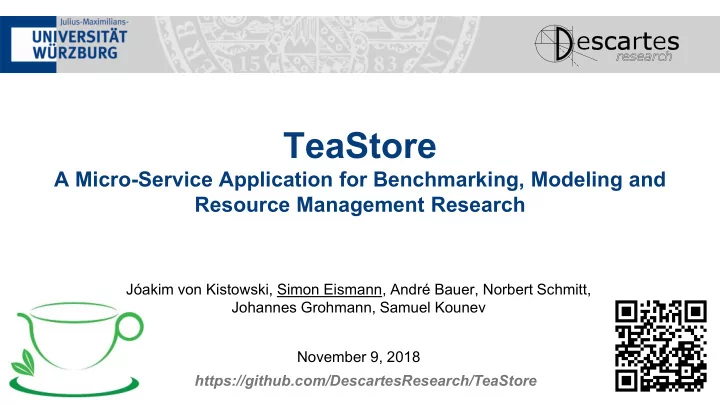

TeaStore A Micro-Service Application for Benchmarking, Modeling and Resource Management Research Jóakim von Kistowski, Simon Eismann, André Bauer, Norbert Schmitt, Johannes Grohmann, Samuel Kounev November 9, 2018 https://github.com/DescartesResearch/TeaStore
Example Research Scenario ? ? A, B, C? Service Service Service A B C ? Many solutions for these questions have been proposed, however… Introduction TeaStore Use-Cases Conclusion 2 TeaStore: Micro-Service Benchmarking Application
Challenge How to evaluate Reference applications help to Placement algorithms Evaluate model (extractor) accuracy Auto-scalers Measure auto-scaler New modeling formalisms elasticity Model extractors Measure placement power consumption and performance Require realistic reference and test applications Introduction TeaStore Use-Cases Conclusion 3 TeaStore: Micro-Service Benchmarking Application
Requirements for a Test Application Scalable Allows for changes at run-time Reproducible performance results Diverse performance behavior Dependable and stable Online monitoring Load profiles Simple setup Modern, representative technology stack Introduction TeaStore Use-Cases Conclusion 4 TeaStore: Micro-Service Benchmarking Application
Existing Test Applications RUBiS [1] eBay-like bidding platform Created 2002 Single service SPECjEnterprise 2010 [2] SPEC Java Enterprise benchmark Three tier architecture No run-time scaling Database is primary bottleneck Sock Shop [3] Microservice network management demo application Created 2016 Low load on non-network resources Dell DVDStore, ACME Air, Spring Cloud Demo, and more in our MASCOTS paper [4] Introduction TeaStore Use-Cases Conclusion 5 TeaStore: Micro-Service Benchmarking Application
The TeaStore Micro-service test application Reg- WebUI Five services + registry istry Netflix “Ribbon” client-side load balancer Persis- Kieker APM [5] Recom- Auth Image mender tence Documented deployment options: Manual Docker images Database Kubernetes Introduction TeaStore Use-Cases Conclusion 6 TeaStore: Micro-Service Benchmarking Application
Services I Registry RegistryClient Simplified Netflix Eureka Dependency for every service Service location repository Netflix “Ribbon” Heartbeat Load balances for each client WebUI Authentication Servlets/Bootstrap Session + PW validation Integrates other services into UI SHA512 + BCrypt CPU + Memory + Network I/O CPU Introduction TeaStore Use-Cases Conclusion 7 TeaStore: Micro-Service Benchmarking Application
Services II PersistenceProvider ImageProvider Encapsulates DB Loads images from HDD Caching + cache coherence 6 cache implementations Memory Memory + Disk I/O Recommender TraceRepository Recommends pro- AMQP Server ducts based on history Collects traces from all 4 different algorithms services Memory or CPU Introduction TeaStore Use-Cases Conclusion 8 TeaStore: Micro-Service Benchmarking Application
Load and Usage Profiles (1/2) HTTP load generator [5] Supports varying load intensity profiles Arrival rate Can be created manually Or using LIMBO [6] time Scriptable user behavior Uses LUA scripting language “Browse” and “Buy” profiles on GitHub https ps://git github.com/ m/jo joakimk imkis istowski/ i/HTT TTP-Loa Load-Gen ener erato tor Introduction TeaStore Use-Cases Conclusion 10 TeaStore: Micro-Service Benchmarking Application
Load and Usage Profiles (2/2) JMeter Commonly used load generator Browse profile for JMeter Identical to HTTP Load Generator profile Introduction TeaStore Use-Cases Conclusion 11 TeaStore: Micro-Service Benchmarking Application
Evaluation Teaser: Does it scale? Scales linearly Stresses 144 cores on 9 physical hosts HTTP Load Generator handles > 6000 requests per second Introduction TeaStore Use-Cases Conclusion 12 TeaStore: Micro-Service Benchmarking Application
Evaluation Three Use-Cases Performance modeling Auto-scaling Measuring energy-efficiency of placements Goal: Demonstrate TeaStore’s use in these contexts Introduction TeaStore Use-Cases Conclusion 13 TeaStore: Micro-Service Benchmarking Application
Performance Model - Scenario Question: How does utilization change with the default # products per page ? Approach: Create two workloads with different products per page distributions Create and calibrate performance model with default distribution Predict performance for Different products per page distribution Different service placement Introduction TeaStore Use-Cases Conclusion 14 TeaStore: Micro-Service Benchmarking Application
Performance Model - Models Products per Page Distribution Calibration To Predict Deployment Calibration To Predict Introduction TeaStore Use-Cases Conclusion 15 TeaStore: Micro-Service Benchmarking Application
Performance Model - Results Results with and without considering the parametric dependency using Service Demand Law-based model Introduction TeaStore Use-Cases Conclusion 16 TeaStore: Micro-Service Benchmarking Application
Auto-Scaling - Scenario Reactive Auto-Scaling Scenario Resource… Resources Challenge: Scale in an elastic manner so that # services matches demand Additional Challenge: Which service to scale? Approach: 0 4 8 12 16 20 24 Hour of Day Create heterogeneous configuration order Put TeaStore under varying load Decide scale-up / scale-down using research auto-scaler REACT [7] Introduction TeaStore Use-Cases Conclusion 17 TeaStore: Micro-Service Benchmarking Application
Auto-Scaling - Results BibSonomy Trace FIFA Trace Under- and overprovisioning-timeshare <= 15% TeaStore can be used for auto-scaler evaluation Open challenge: Which service to scale next? Introduction TeaStore Use-Cases Conclusion 19 TeaStore: Micro-Service Benchmarking Application
Energy Efficiency - Scenario Energy efficiency of placements Goal: Show that power consumption, energy efficiency, and performance scale differently Different optima for service placements Approach: Distribute TeaStore on homogeneous and heterogeneous servers Put TeaStore under load using increasing stress-test load intensity Measure TeaStore performance and server wall power Introduction TeaStore Use-Cases Conclusion 20 TeaStore: Micro-Service Benchmarking Application
Energy Efficiency - Measurement Measurements in homogeneous and heterogeneous setting SUT 1: 16 core Haswell 32 GB RAM SUT 2 (Heterogeneous): 8 core Skylake 16 GB RAM Metrics: Throughput Power Energy Efficiency Throughput / Power Introduction TeaStore Use-Cases Conclusion 21 TeaStore: Micro-Service Benchmarking Application
Energy Efficiency – Optima for Heterogeneous Placement Placement Candidate 1 Placement Candidate 2 16 cores 8 cores 16 cores 8 cores Web Web Web Web UI UI UI UI Auth Auth Auth Auth Rec- Rec- omm. omm. Img Img Img Img Per- Per- Per- Per- sist. sist. sist. sist. Max 1067.7 Tr/s Max 1011.9 Tr/s Max 187.0 W Max 179.6 W Geo 4.3 Tr/J Geo 4.4 Tr/J Introduction TeaStore Use-Cases Conclusion 22 TeaStore: Micro-Service Benchmarking Application
TeaStore - Conclusions Teastore can be used for • Performance modeling evaluation Auto-Scaler evaluation Placement and energy-efficiency evaluation Micro-service reference application Five Services + Registry Different resource usage characteristics Kieker monitoring Load Generators and Load Profiles Kubernetes support Under Review by SPEC RG https:// //gith thub.co com/D /Des escar carte tesRes esea earch/T /TeaS aSto tore Introduction TeaStore Use-Cases Conclusion 23 TeaStore: Micro-Service Benchmarking Application
Thank You! From the TeaStore Dev Team All tools available at: https://github.com/DescartesResearch/TeaStore HTTP Load Generator https://github.com/joakimkistowski/HTTP-Load-Generator LIMBO Load Intensity Modeling Tool http://descartes.tool ools/ http://descartes.tools/limbo Kieker Application Monitoring http://kieker-monitoring.net Introduction TeaStore Use-Cases Conclusion 24 TeaStore: Micro-Service Benchmarking Application
Recommend
More recommend